Purslane: Recipes and Information with the Wonder Plant
 Condemned by some as an unsightly, pervasive weed," purslane is also a free backyard source of protein, vitamin E, vitamin C, and the best source of Omega 3 fatty acids of any leafy plant.
Condemned by some as an unsightly, pervasive weed," purslane is also a free backyard source of protein, vitamin E, vitamin C, and the best source of Omega 3 fatty acids of any leafy plant.
There's no reason to spend money on fish oil supplements if you have this tasty food source growing in your backyard or vegetable garden. In this article we provide a little background on this healthful plant, plus some easy to make purslane recipes.
Whether you eat it raw in salads, stir-fried, or added to soups and sauces, purslane is a delicious addition to many recipes. It's easy to grow, tastes great, and - best of all to anyone struggling with rising food prices - it's free.
Purslane used to be cultivated as a food crop in the United States, and is still a major food drop in many countries, including India. Its popularity has increased recently, with articles in the Washington Post and other publications highlighting the nutritional benefits and taste of this hardy little weed:
The plant is rich in vitamin E, vitamin C and beta carotene, and quite high in protein. Most noteworthy of all, it is considered a better source of essential omega-3 fatty acids than any other leafy plant. These are compounds the body cannot make itself, which are needed to complement the omega-6 fatty acids we get from grains and grain-fed meat. Wild-caught salmon and freshly hulled walnuts also deliver this prize, but for a steady supply what could be handier than a plant that leaps into your own personal food system with the ardor of an overactive puppy?
How to harvest Purslane
Harvesting purslane is easy; it grows just about anywhere that gets two frost-free months per year and loves to spread around cultivated fields, back yards, and any place that has fertile, moist soil. Even so, purslane is drought-tolerant and readily reseeds from one year to the next.
Take care when picking wild purslane though. Be sure the field hasn't been sprayed with pesticides or other dangerous chemicals. Avoid picking directly next to roads because car exhaust can contaminate plants with chemicals and heavy metals.
Also make sure you're actually picking purslane and not its evil twin: spurge. Purslane is a healthy food, but spurge will make you sick. Note the difference in these pictures. The purslane stems are thicker and succulent, as are the leaves. But spurge stems and leaves are much thinner, and when the stems are broken, leak a milky sap that irritates the skin. The white sap means the plant is spurge, so feel free to pull it up to make room for more purslane.
Here's a photo of spurge and another of the milky sap from a broken spurge stem:
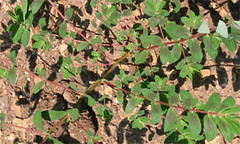
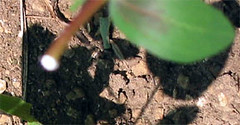
Purslane Recipes
The easiest way to add purslane to your diet is to toss a few, washed leaves into your salad or stir fry. The crunchy, zesty flavor has a slight lemony, peppery kind of flavor.
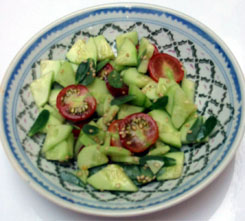
- Ingredients:
- 1 cup cucumber, halved lengthwise and sliced.
- ⅔ cup halved cherry tomatoes
- ½ cup purslane leaves
- 2 teaspoons toasted sesame seeds
- 2-3 Tablespoons rice vinegar (start with 2 tablespoons, and add more if needed)
- 1-2 teaspoons sugar
- Mix all ingredients together in a bowl, cover, and chill in the refrigerator until ready to serve.
Prep Time: 10 minutes
Cook Time: 30 minutes
Yield: 4
- 3 cups potatoes, cut into 1 inch chunks, and boiled just until tender.
- 3 stalks celery, minced
- 1-2 green onions and stems, diced
- ½ cup sliced bell pepper
- 2/3 cup raw purslane leaves
- ½ to 2/3 cup mayonnaise
- 1 tablespoon red wine vinegar
- 1 teaspoon curry powder
- salt and pepper to taste
While potatoes are still warm, add remaining ingredients and stir well to coat vegetables. Cover, and chill in the refrigerator until ready to serve.
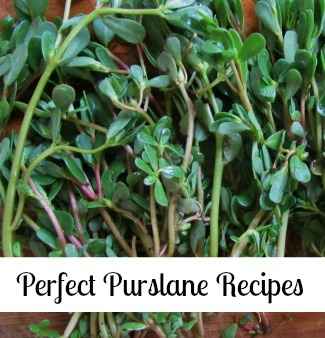



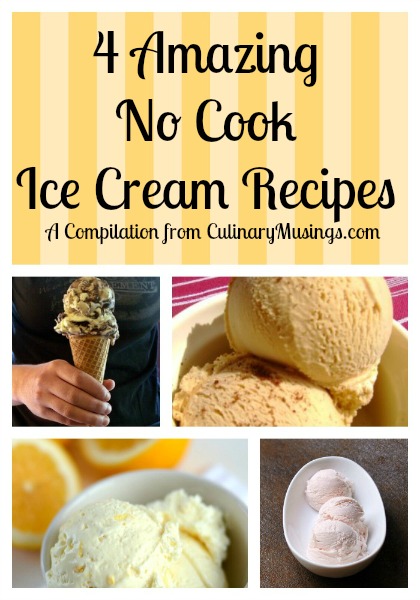

In your Purslane Potato Salad with Curry, you failed to list purslane as an ingredient and therefore we have no idea of how much to use. Also, you make no mention of it in the directions section of the recipe.
How much purslane and, when and how is it incorporated? Is it cooked or blanced or raw whe added to the salad???
Hey Eileen!
DUH. So focused on the Purslane that I forgot it!
I don’t cook it, just wash the leaves and toss a handful in. You can use as much or as little as you want. In this recipe, I put in about 2/3 cup of raw Purslane. We usually eat it raw in salads, but it tastes good added to stir fries too.
Thanks for that catch. I’m going to try to update the post so the recipe will be correct.
The curry potato salad is magnificent! My family gobbled it up, and is now looking for more. (I used grape seed oil vegenaise mayonaise for this salad for an even healthier treat.) I will definitely add this to my favorite recipes folder. Thanks!
if I wanted to plant it in the containers on my balcony where could I get the seeds or plants-i.e. any specific store that exists in the greater boston area? i.e.home depot, whole foods? I am disableed and haVE A HARD TIME BENDING AND PICKING AND GOing to areas off the beatten (sp?) track
thank you for sharing
Cam you grow Purslane in pots on the patio? I am in an area that gets lots of sun, but can be very windy.
Hi Eileen,
The purslane potato salad does have the purslane listed as an ingredient and directions. 2/3 cup raw purslane leaves… and it says to mix with other remaining ingredients to coat vegetables. That would include the purslane leaves. Hope this helps.
Where can you buy purslane seeds so that you can start growing it?
Love learning about new things And this is a good one I have been weeding this out of my garden for years thank you soo much When you are on disable social security I need all the help that I can get. I plant a garden with veg and all I plant ALots of herbs also. dry them Ov freeze them I water
Great info, didn’t know about spurge. We have lots of purslane in the garden, would like a recipe for a drink. Also anyone know how much you have to eat to get all the benifits?
Thanks
Very cool knowledge, hey maybe we could add some dandelion leaves too as they are good for you also! Hugs Deb
As soon as I read the article, I went out and picked the last few bits of purslane left in my garden.
I love it!!!!
I put some in my leaf letttuce salad and in the cooked greens I fixed for supper.
I cooked up the weed “lamb’s quarters” with some purslane,kale, green onions, a spoonful of bacon fat (I always keep some of the fat drippings in my freezer),ground pepper, sea salt and some fresh herbs fom my gardens. This time I used basil, rosemary, salad burnet and french tarragon. You wouldn’t have to add any of the herbs and it would still be great-maybe even better.
Lamb’s quarters tend to grow around or in new gardens. I leave some g to seed just for eating purpose. I don’t have a camera to take any pictures to show you. You use them just like spinach. I do like them cooked better than raw.
I know about eating dandelions and cat-tail roots; are there other common weeds that are edible? I sure hope pigweed has a way of making it edible. That is more than abundant in my garden.
Thank you for the information and recipes on purslane. Oh- my dog also loves them.
“Pigweed” is a term applied to more than one plant, but could be amaranth, all parts of which are edible. The young leaves are a good cooked green, but get a little bitter when older. I’m hoping to collect some seeds this year to experiment with cooking them (like oatmeal).
I just introduced my six-year-old granddaughter to purslane and she liked it so much, I let her go out and harvest her own from the garden. I think she likes the lemony taste.
As for growing purslane in pots, we had some come up in a pot that had held a small tree that died–I think the birds planted it. It produces lots of seeds, so you just need to get a flowering sprig from someone’s yard and you’re in business.
wonderful research I, write and research plants that most call weeds so many that are pulled and wasted are so good and many medicinal wonders I must locate this!
wow… one man’s food is really another man’s poison… this same plant grows at the back of our family house yard… but we cut it off, just like the unwanted grass… now am seeing in this blog that its also a source of vitamins… i need some one to tell me how i can make good use of it…we have a lot of em… brilliant blog
________
Acai Optimum
ParaSlim
Had I but known. Before going on leave for three weeks I spread composted chicken manure over all my beds and veggie garden. When we came back after three weeks my garden was overgrown with Purslane. I spent a whole week trying to eradicate what I thought to be a weed. After reading your article I went out into the garden and hunted for some remains very scarce now and I agree it is delicious. Will add a bit to my stir fry tomorrow if I can find enough. Will broadcast the good news to all I know. Most grateful to find such a valuable source of Omega3 which costs a fortune at the best of times
It would seem that the chickens at Rocklands Poultry are fed this plant as fodder as it only appeared after this application. Have never had it in the garden before now. Can imagine chickens doing well on this
Added to my favourites list and added to my blogroll.
Wow, I had no idea you could eat purslane and that it was good for you. Thanks for enlightening me. 🙂
I’ve just started using purslane, after spending many tedious hours pulling it out our gardens over the years. There are at least two purslane varieties, the common, small-leafed and ground-hugging “weed,” and a much larger, equally easy to grow “golden purslane.” The wild variety has a tangy taste that’s missing in the larger variety, but both are very good to eat and best of all, if you plant the golden purslane, it will grow up rather than sideways and help to shade out other, less edible weeds. Golden purslane, like its smaller cousin, also seeds itself, so once planted, with one or two plants let go to seed, you can always expect to have golden purslane growing wherever you want it in your garden.
After learning about purslane, I just made some zucchini bread and since I don’t peel the zucchini and the bread already has green specs in it, I decided to add some purslane in place of some of the zucchini. My husband and kids didn’t know the difference. I wasn’t sure how it would turn out so to start with I only subsituted 1/4 cup of purslane for 1/4 cup of the zucchini. I put it in the food processer and chopped it real fine. Unless you tell them, they’ll never know. I used the Betty Crocker Zucchini bread recipe that makes 2 loaves.
i live in Sweden and happy to find it is sold at local farmers market! not expensive.
but what about the thick stems? the leaves taste fine, but the stems are not so tasty. should one eat the stems too? maybe they need to be cooked; the leaves go very well in a cool salad.
thanks for info
I’ve eaten this weed since I was a kid. It’s called “verdolagas” in spanish. My grandfather from Mexico used to preserve it in jars, and serve it as an accompaniment to a main dish. My wife & I like it poached, then cooled and served as a salad with chopped onions and tomatoes, topped with a little lemon & soy sauce. I had no idea it was so good for you!
Purslane is wonderful stuff–we used to buy it in the market when my family lived in the middle east. Salad greens, or like a parsley in soups, chopped up in meat kabobs, or put on the flatbread with Greek yogurt (tzatziki) and the hot meat wilts it a little. My housekeeper would harvest it free to feed her children. It also is good blended up with lemon juice and water plus a bit of honey, (think wheatgrass smoothie) and it’s one of the healthiest greens existing–and we spray poison on it here, and fertilize GRASS, then pay a mint for organic, natural vitamin pills. God must have a real headache! Providing us with healthy things free, and watching us run around like idiots!
Oh, and purslane is WONDERFUL in veggie burgers!!
I would like to know were to buy PURSLANE supplements and seeds. Thank You EW
I would like to know where I can buy PURSLANE supplements and seeds. Thank You EW
You can trim off the stems if they are too thick and woody.
I lived in Atlacomulco Mexico for 3 years. The morning vendors used to make a wonderful tamal (called a Oaxaqueno) that contained this “weed” (called verdolagas in Spanish). In addition to the verdolagas, the tamal contained a spectacular black mole sauce, an entire (skinless) chicken leg (cooked in boiling water with LOTS of white onion & bay leaves) & Oaxaca cheese (similar to string cheese). The whole thing was wrapped/steamed in a banana leaf (which gave it a wonderful flavor). Man, those were GOOD!!!!!!!
I use purslane in green salads in place of other greens, but also in sandwiches where you can pile on a lot. Its tastes great and is nicely crunchy.
Thanks so much for the great info and recipes for this common, easy to find plant. Are the ornamental varieties found in garden centers also edible? I’ve bought several varieties for their brightly colored flowers (yellow, pink, red, and coral) which are much larger than the flowers of wild purslane for use as understory plants in my potted ornamental trees and have found that they are easily reproduced by laying broken pieces on top of the soil. If these ornamental varieties are also edible, are their flowers edible as well, as is the case with nasturtium? Thank you for any information you can provide on this topic.
Ornamental varieties are edible, but since they’ve been bred to produce prettier blossoms, the flavor and nutrition will suffer. The flowers of both wild and ornamental plants are edible, and this a case where using the ornamental plants (with their showier flowers) would make sense.
i have a cat that was just diagnosed with diabetes. Can I use purslane to treat her? If so what would be the correct amount to give her?
Boy am I needing a smack on the head. For many years I have been fighting this weed in my garden. This year it is very prevalent. I just spent three to four hours pulling this plant out and tossing it. I will try some now.
I was told the French brought it over so many years ago even before the English came.
Sorry, Carol: this is a cooking site, not a pet medicine site. I would not know how to advise you.
Read about purslane a little while ago and wondered if the weed in my yard was purslane. Took one to the extension office here, just to be sure, and was pleased to have it verified. Now I can’t wait to try it. How can I preserve it? Does it freeze well? What would be the best way to save it and keep the nutrients? Would it dry well? Sorry for so many questions, but I’m so excited about free food and I want to do it right. And to think I used to curse it and pull it out as a weed.
I grew up eating this in summer sandwiches with garden fresh tomatoes & mayo.
My grandfather called it “pig’s parsley”.
Have re-discovered it this year. Delicious!
One of my favorite (and super simple) ways to cook purslane is a light saute in a tiny bit of olive oil with lemon juice and minced garlic to taste. This was how I had my first taste of it, is quick and easy, and is still a favorite preparation, as a snack, appetizer, side, or topping to meat/rice/veggies/noodles/toast.
You can dry purslane, and it is often used that way (whole or ground into a powder) and used to thicken soups, sauces, etc. Drying it is also supposed to remove some of the bitterness, especially with wild varieties.
I HAVE A LOT GROWING IN MY GARDEN TOO AND WAS WONDERING IF WE CAN USE IT TO REHABILITATE THE OVER-GRAZED MOUNTAINS AROUND US..ARE THERE ANY STUDIES DONE ON PURSLANE WHEN IT COMES TO RESTORATION WORK?
I WANT TO START MAKING AN OLIVE -BASE SALAD DRESSING WITH IT…ANY RECIPES AVAILABLE?
I FIND IT A BIT ‘SLIMY’…IS THAT NATURAL AND SHOULD I RATHER COOK OR BAKE USING IT ?
THANKS
SUSAN
It’s good raw as a part of a mixed green salad and works well stir-fried. I have not tried baking with it.